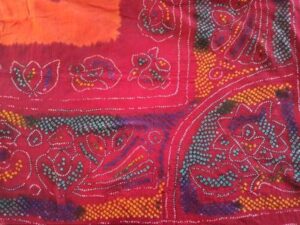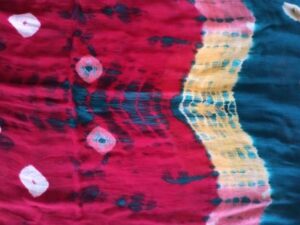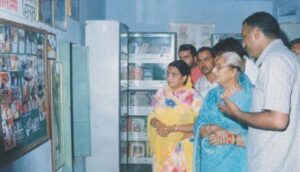Tie & Dye
Tie & Dye Training Project: A Step Towards Atmanirbhar Women
Period of the Project: June 1, 2006, to May 31, 2007.
Funding Agency: Council for Advancement of People’s Action and Rural Technology (CAPART) (Presently known as National Institute of Rural Development (NIRD)), Ministry of Rural Development, Govt. of India.
Despite continuous efforts advocated by the state government for economic empowerment of women, 73% of total women in the age group of 15-59 are still unemployed, says 2011 census data. The state Rajasthan has performed very poorly in front of literacy as well as in female work participation rate while literacy and female work participation rate gap in rural-urban, as well as male-female, is widely seen. After an intensive survey by Kamalnishtha Sansthan, it is found that tie-dye work has glorious potentiality for women’s income generation. The textile industry in India has a colourful heritage consisting of a diverse range of techniques and traditions. Tie and dye are one of the most popular and widespread textile art of Rajasthan. It constitutes an important segment of the de-centralized/ unorganized sector of our economy. It is mainly rural-based, having reach in the backward and inaccessible areas. Originally, started as a part-time activity in rural areas, it has now transformed into a flourishing economic activity due to significant market demand over the years. Tie-Dye has big potential as they hold the key for sustaining not only the existing set of millions of artisans spread over the length and breadth of the country but also for an increasingly large number of new entrants in this activity.
potentiality for women’s income generation. The textile industry in India has a colourful heritage consisting of a diverse range of techniques and traditions. Tie and dye are one of the most popular and widespread textile art of Rajasthan. It constitutes an important segment of the de-centralized/ unorganized sector of our economy. It is mainly rural-based, having reach in the backward and inaccessible areas. Originally, started as a part-time activity in rural areas, it has now transformed into a flourishing economic activity due to significant market demand over the years. Tie-Dye has big potential as they hold the key for sustaining not only the existing set of millions of artisans spread over the length and breadth of the country but also for an increasingly large number of new entrants in this activity. Presently, this sector is contributing substantially in employment generation and export but this sector has suffered due to the very nature of being unorganized with additional constraints like lack of education, capital, poor exposure to new technologies, absence of market intelligence, and poor institutional framework. Traditional Tie & Dye activities on cotton fabrics, which are used in handmade designs on traditional Rajsthani wear i.e. odhani, blouse, kurta, salwar, turban, etc. are being worked in the field (Kolsiya and surrounding villages) at a very small level. It was realized that if provided with all necessary bits of help for upgrading their skill, for production and marketing and favourable environment then we can utilize this unemployment into nation-building and it also, will be a concrete step to make these women self-dependent and sufficient.
Presently, this sector is contributing substantially in employment generation and export but this sector has suffered due to the very nature of being unorganized with additional constraints like lack of education, capital, poor exposure to new technologies, absence of market intelligence, and poor institutional framework. Traditional Tie & Dye activities on cotton fabrics, which are used in handmade designs on traditional Rajsthani wear i.e. odhani, blouse, kurta, salwar, turban, etc. are being worked in the field (Kolsiya and surrounding villages) at a very small level. It was realized that if provided with all necessary bits of help for upgrading their skill, for production and marketing and favourable environment then we can utilize this unemployment into nation-building and it also, will be a concrete step to make these women self-dependent and sufficient.
To know about the needs of the local rural women, their meeting was organized by Kamalnishtha Sansthan, and based on the suggestions made by them, a management committee was formed to formulate the project and also for its management and implementation, which comprised of the village head, two nominees of the proposed beneficiaries and other two from the proposed mercury institution. Soon after the sanction of the proposed Tie & die training programme from CAPART, Kamalnishtha Sansthan launched an awareness campaign and started the mobilization of beneficiaries. Women mainly landless, marginal farmers, uneducated, unemployed & backward classes were selected as beneficiaries in this project. The preferred age group is between eighteen to forty-five, irrespective of caste and colour, all poor, downtrodden women of the area were permitted in this project. After the acceptance of 40 women members communicated to CAPART, training of beneficiaries started on 1st June 2006. Beneficiaries were involved in the project right from its formulation until its implementation in full. The training task has been completed on 31 May 2007. Under this program,
- ͽ Women were trained for performing traditional Tie- Dye activities on cotton fabrics, which are used in handmade designs on traditional Rajsthani wear i.e. odhani, Ghagra-Chuni, blouse, kurta, salwar, turban, etc.
- ͽ It enabled them to develop and master the skills on the related items (tie, die, and marketing) and made them eligible for credit facilities from Bank.
- ͽ They are now self-employment and have opened a path for a better life for themselves by using local resources and can be helping hand in nation-building.

Visit of Smt. Sumitra Singh at KNS during the project
Smt. Sumitra Singh Speaker Rajasthan Legislative Assembly visited the training site on August 4, 2006, and gave her blessing and motivated the group of women for successfully running the activities after completion of the training programme.
Sustainability: Sustainability of the project is assured as in the long run, beneficiaries (Producers) can change their items and quality according to time as the products are household usual and the product will never be “backdated”. Selling the final product and purchasing raw material will form a cycle and thus they will continue production work and this will sustain positively. The self-help-group and co-operative will come under the “Microcredit system” easily by respective rural and co-operative banks. They will get finance to purchase vessels for dying & other items.
Impact: The project has certainly helped in improving the skills of rural beneficiaries and they have gained confidence for micro-enterprise, whereby they can continue with income generation activities even after the training. Women beneficiaries and their families express their gratitude for the assistance and training received from Kamalnishtha Sansthan to enable them to start self-employment income generation to supplement their family income. This project is a step towards the revival of Bundi-Bandhej, which is on the verge of extinction in the Shekhawati region of Rajasthan and also a ray of hope for innumerable artisans towards attaining self-sufficiency.